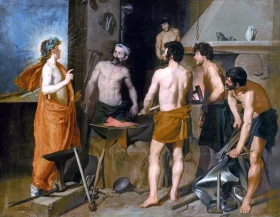- Choose your Country
- Choose your Country
Diego Velazquez
Diego Rodríguez de Silva y Velázquez, an esteemed painter from Spain, holds a significant place in the annals of art history. Born on June 6, 1599, Velázquez rose to prominence during the Spanish Golden Age, serving as the principal artist in the court of King Philip IV of Spain and Portugal. His journey through the Baroque period, spanning from approximately 1600 to 1750, marked a transition from precise tenebrist techniques to a more expressive style characterized by bold brushstrokes. Velázquez’s oeuvre encompasses a plethora of historical and cultural scenes alongside numerous portraits of the Spanish royalty and commoners. Among his masterpieces, “Las Meninas” stands out as an epitome of his genius, completed in 1656.
Velázquez’s influence transcended his era, leaving an indelible mark on subsequent generations of artists. Realist and impressionist painters of the 19th century drew inspiration from his works, while 20th-century luminaries like Pablo Picasso, Salvador Dalí, and Francis Bacon paid homage to Velázquez by reinterpreting his iconic imagery.
Although much of Velázquez’s work found its way into the Spanish royal collection, his legacy extends far beyond the confines of his homeland. His paintings, renowned for their realism and depth, continue to captivate audiences worldwide, with the Museo del Prado in Madrid housing the most extensive collection of his works.
Velázquez’s early life in Seville laid the foundation for his illustrious career. Born to modest beginnings on June 6, 1599, he showed an early aptitude for art and was apprenticed to Francisco Pacheco, a prominent artist and educator in Seville. Under Pacheco’s tutelage, Velázquez honed his skills, delving into the classics and mastering techniques of proportion and perspective.
In 1618, Velázquez tied the knot with Juana Pacheco, the daughter of his mentor, Francisco Pacheco. This union bore two daughters, Francisca and Ignacia, and marked a significant milestone in Velázquez’s personal life. His early works, such as “Old Woman Frying Eggs,” showcased his prowess in realistic depiction and garnered attention for their dramatic lighting and meticulous detail.
Velázquez’s sojourn to Madrid in 1622 proved pivotal in his career trajectory. Although initially barred from painting King Philip IV, he garnered acclaim for his portrait of the poet Luis de Góngora. Following the death of Rodrigo de Villandrando, Velázquez received a summons from Gaspar de Guzmán, Count-Duke of Olivares, propelling him into the royal court’s inner circle.
His tenure in Madrid saw the creation of notable works like “Philip IV in Brown and Silver” and “The Triumph of Bacchus.” Velázquez’s artistic prowess earned him accolades and secured him a prominent place in the king’s retinue.
A sojourn to Italy in 1629 provided Velázquez with fresh perspectives and artistic inspiration. His encounters with Italian masters left an indelible imprint on his style, as evidenced by works like “Joseph’s Bloody Coat brought to Jacob” and “Apollo in the Forge of Vulcan.”
Velázquez’s return to Madrid ushered in a prolific period marked by iconic portraits and historical depictions. His equestrian portraits of Prince Balthasar Charles and Philip IV showcased his ability to capture regal splendor with unparalleled finesse.
In 1634, Velázquez immortalized the Surrender of Breda, a poignant portrayal of Spanish military prowess during the Eighty Years’ War. This masterpiece exemplifies Velázquez’s penchant for imbuing historical narratives with human emotion and dignity.
The latter years of Velázquez’s career witnessed the creation of timeless portraits like “The Spinners” and “Infanta Margarita Teresa in a Blue Dress.” Despite his acclaim, Velázquez remained humble, devoting himself to his craft until his passing on August 6, 1660.
Velázquez’s legacy endures as a testament to the transformative power of art. His paintings transcend time and place, inviting viewers into a world of beauty, intrigue, and humanity. As we reflect on his life and work, we are reminded of the enduring legacy of one of history’s greatest painters.
Read moreShowing 1–100 of 116 results




































































































